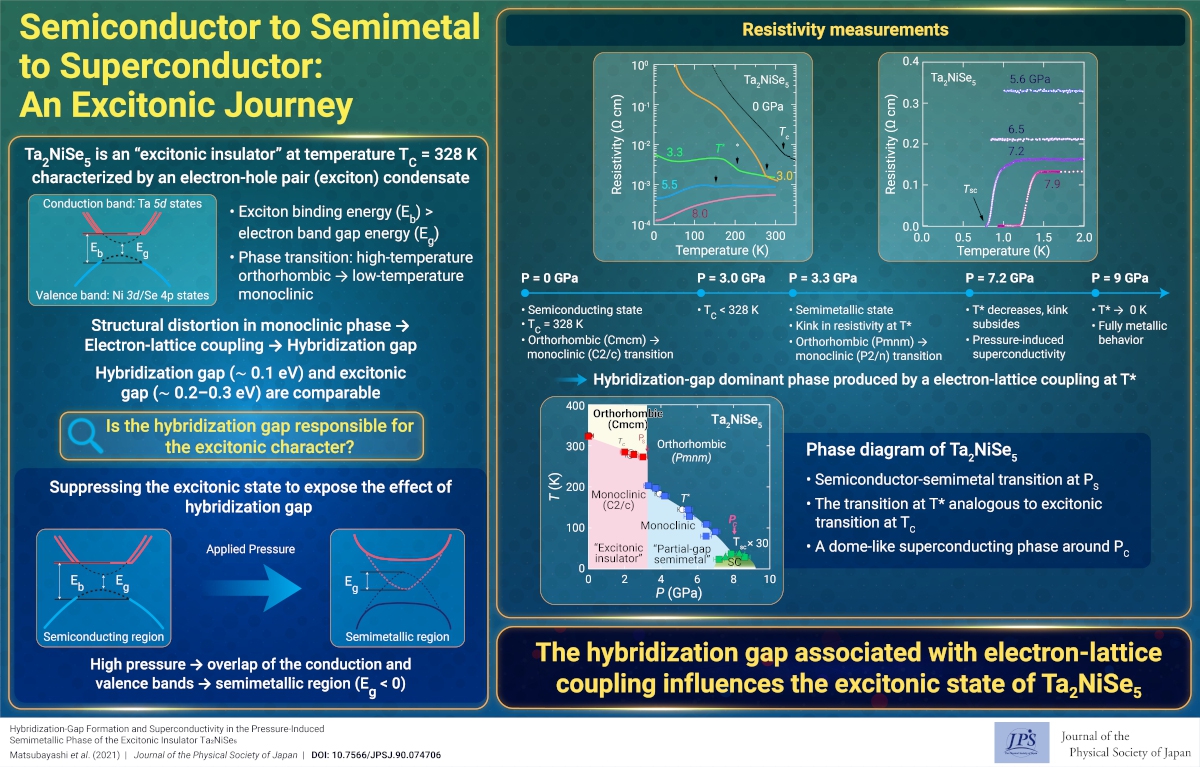Semiconductor to Semimetal to Superconductor: An Excitonic Journey
© The Physical Society of Japan
This article is on
Hybridization-gap Formation and Superconductivity in the Pressure-induced Semimetallic Phase of the Excitonic Insulator Ta2NiSe5
(JPSJ Editors' Choice)
J. Phys. Soc. Jpn.
90,
074706
(2021)
.

Superconductors comprise a condensate of electron pairs, known as Cooper pairs, capable of electricity conduction without energy loss. Conventional superconductivity involves the formation of electron pairs via the attractive interactions mediated by lattice vibrations. Excitons are the bound states generated via Coulomb attraction between electrons and holes, similar to that for the Cooper pairs in superconductivity. The ineffective screening of Coulomb interactions in narrow-gap semiconductors and semimetals is expected to induce the spontaneous condensation of excitons with a decrease in temperature. Consequently, the system becomes an excitonic insulator.
Superconductivity was initially observed in mercury in 1911; subsequently, various superconducting materials, including high-temperature superconductors, were discovered. Conversely, the theoretical proposal of excitonic insulators over 50 years ago was not subsequently validated by conclusive experimental evidence of the excitonic state.
Ta2NiSe5 is a layered chalcogenide located near the semiconductor–semimetal boundary. Recently, this compound has attracted significant attention as a promising candidate for excitonic insulators. Furthermore, there is renewed interest in the formation of a gapped state driven by electron–lattice coupling. The applied pressure is an ideal controlling parameter to tune the electronic states. To the best of our knowledge, the present research was the first to report a high-pressure phase diagram for Ta2NiSe5 encompassing the entire range i.e., from the semiconducting to semimetallic region. The investigations revealed pressure-induced superconductivity in the semimetallic phase.
A transition to another semimetal with a partial gap was observed in the pressure-induced semimetallic phase. This was accompanied by lattice distortion analogous to that occurring during excitonic transition in the low-pressure semiconducting phase. An increase in the carrier density facilitated effective screening of the Coulomb interactions between electrons and holes. Therefore, the gap characteristics changed from excitonic dominant to hybridization-gap dominant with an increase in the band overlap under an applied pressure. The results revealed the critical role of electron–lattice coupling in the occurrence of superconductivity and excitonic transition in the low-pressure phase.(Written by Kazuyuki Matsubayashi on behalf of all authors.)
"Hybridization-gap Formation and Superconductivity in the Pressure-induced Semimetallic Phase of the Excitonic Insulator Ta2NiSe5
(JPSJ Editors' Choice)
J. Phys. Soc. Jpn.
90,
074706
(2021)
.
Share this topic
Fields
Related Articles
-
Fractional Vortex Array with Nontrivial Topological Structure Realized at Twin Boundary of Nematic Superconductor
Superconductivity
2025-3-24
Analysis of the two-component Ginzburg-Landau theory suggests that a conventional vortex is transformed into two fractional vortices with the topological nature of core-down and core-up merons at the twin boundary of a nematic superconductor.
-
Exploring the Vibrant Interplay of Machine Learning and Physics
Cross-disciplinary physics and related areas of science and technology
Electron states in condensed matter
Elementary particles, fields, and strings
Mathematical methods, classical and quantum physics, relativity, gravitation, numerical simulation, computational modeling
Statistical physics and thermodynamics
Superconductivity
2025-3-13
This Journal of the Physical Society of Japan Special Topics edition explores how physics and machine learning complement each other and can solve unresolved problems in physics.
-
A Unified Theory of Topological Hall Effect
Electronic transport in condensed matter
2025-3-6
This paper presents a unified theoretical description for the topological Hall effect, covering the entire region from strong- to weak-coupling, extending its picture beyond the Berry phase.
-
Excitonic Insulators: Challenges in Realizing a Theoretically Predicted State of Matter
Electron states in condensed matter
Electronic transport in condensed matter
2025-3-3
The realization of an excitonic insulator can help in the establishment of a new electronic state in condensed matter physics, one that has the potential to exhibit novel electric, magnetic, and optical responses beyond those of conventional materials.
-
Triangular Lattice Magnet GdGa2: Spin Cycloids and Skyrmions
Cross-disciplinary physics and related areas of science and technology
Electronic transport in condensed matter
Magnetic properties in condensed matter
2025-2-3
Careful measurements were conducted on the hexagonal magnet GdGa2 to reveal the experimental signatures of ultrasmall spin cycloids and of a potential Néel-type skyrmion lattice phase induced by a magnetic field.




